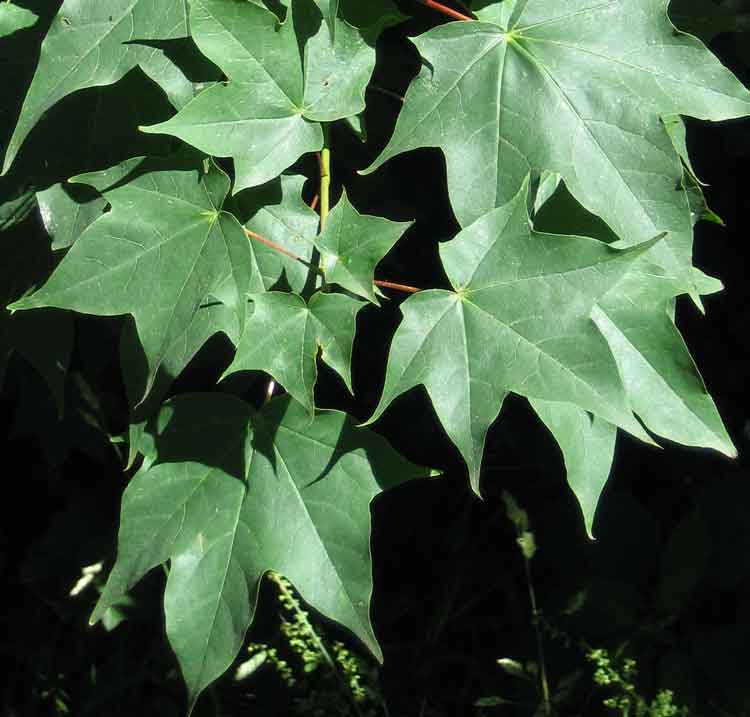
Acer cappadocicum (*)
Classification System: APG IV
Superregnum: Eukaryota
Regnum: Plantae
Cladus: Angiosperms
Cladus: Eudicots
Cladus: Core eudicots
Cladus: Rosids
Cladus: Eurosids II
Ordo: Sapindales
Familia: Sapindaceae
Subfamilia: Hippocastanoideae
Tribus: Acereae
Genus: Acer
Species: Acer cappadocicum
Subspecies: A. c. subsp. cappadocicum – A. c. subsp. divergens – A. c. subsp. sinicum
Name
Acer cappadocicum Gled., Schriften Berlin. Ges. Naturf. Freunde 6: 116 (1785).
References
Schriften der Gesellschaft Naturforschender Freunde zu Berlin 6:116. 1785
Acer cappadocicum at the Euro+Med Plantbase Project
Acer cappadocicum at the Flora of China
USDA, ARS, Germplasm Resources Information Network. Acer cappadocicum in the Germplasm Resources Information Network (GRIN), U.S. Department of Agriculture Agricultural Research Service. Accessed: 08-Apr-12.
Vernacular names
العربية: قيقب كابادوكيا
dansk: Tyrkisk Løn
Deutsch: Kolchischer Ahorn
English: Cappadocian Maple
español: Arce de Capadocia
فارسی: شیردار
français: Érable de Cappadoce
magyar: Pontusi juhar
Nederlands: Colchische esdoorn
polski: Klon kolchidzki
русский: Клён колхидский
Türkçe: Beşparmak akçaağaç
中文: 青皮槭
Acer cappadocicum, the Cappadocian maple, is a maple native to Asia, from central Turkey (ancient Cappadocia) east along the Caucasus, the Himalayas, to southwestern China.[1][2][3][4][5]
Description
It is a medium-sized deciduous tree growing to 20–30 m tall with a broad, rounded crown. The leaves are opposite, palmately lobed with 5-7 lobes, 6–15 cm across. The leaf stems bleed a milky latex when broken. The flowers are in corymbs of 15-30 together, yellow-green with five petals 3–4 mm long; flowering occurs in early spring. The fruit is a double samara with two winged seeds, the seeds are disc-shaped, strongly flattened, 6–11 mm across and 2–3 mm thick. The wings are 2.5–3 cm long, widely spread, approaching a 180° angle. The bark is greenish-grey, smooth in young trees, becoming shallowly grooved when mature.[1][2][4][5]
Taxonomy
There are three varieties, sometimes treated as subspecies:[3][4]
Acer cappadocicum var. cappadocicum. Turkey, Caucasus, northern Iran.
Acer cappadocicum var. indicum (Pax) Rehd. (syn. var. cultratum (Wall.) Bean). Himalaya.
Acer cappadocicum var. sinicum Rehd. Southwestern China.
The closely related Acer lobelii from southern Italy is also treated as a subspecies of A. cappadocicum by some authors.[4] The eastern Asian species Acer amplum, Acer pictum, and Acer truncatum are also very closely related, and often confused with A. cappadocicum in cultivation.[3]
Cultivation and uses
A mature specimen in cultivation in England
Cappadocian maple is grown as an ornamental tree in Europe. Many of the trees in cultivation show a strong tendency to produce numerous root sprouts, a character rare in maples.[1][2] The hybrid maple Acer × zoeschense shares this character and probably has Acer cappadocicum as one of its parents.[2]
The following cultivars have gained the Royal Horticultural Society's Award of Garden Merit:-
A. cappadocicum 'Aureum' (with yellow leaves)[6]
A. cappadocicum 'Rubrum' (with red leaves)[7]
References
Wikimedia Commons has media related to Acer cappadocicum.
Mitchell, A. F. (1974). A Field Guide to the Trees of Britain and Northern Europe. Collins ISBN 0-00-212035-6
Mitchell, A. F. (1982). The Trees of Britain and Northern Europe. Collins ISBN 0-00-219037-0
Bean, W. J. (1976). Trees and Shrubs Hardy in the British Isles 8th ed., vol. 1. John Murray ISBN 0-7195-1790-7.
Huxley, A., ed. (1992). New RHS Dictionary of Gardening. Macmillan ISBN 0-333-47494-5.
Rushforth, K. (1999). Trees of Britain and Europe. Collins ISBN 0-00-220013-9.
"Acer cappadocicum 'Aureum'". RHS. Retrieved 23 February 2020.
"Acer cappadocicum". RHS. Retrieved 23 February 2020.
Retrieved from "http://en.wikipedia.org/"
All text is available under the terms of the GNU Free Documentation License

